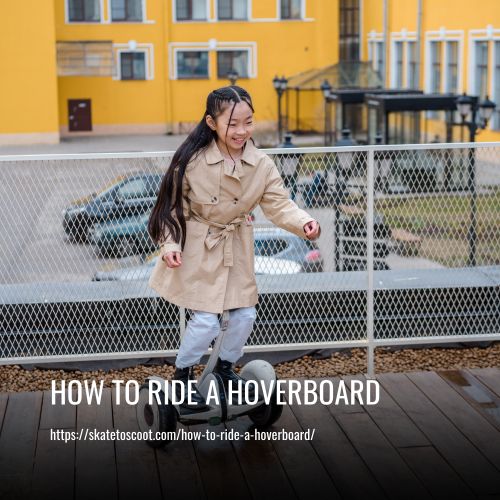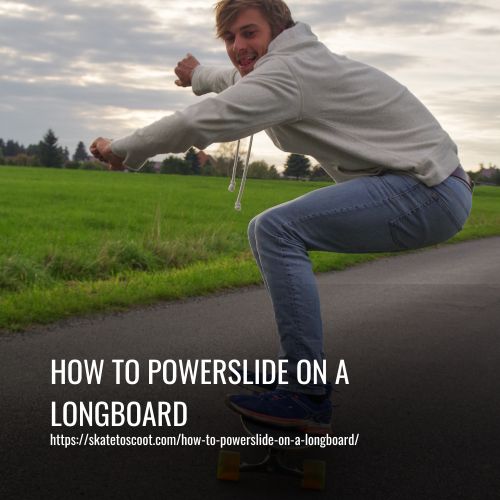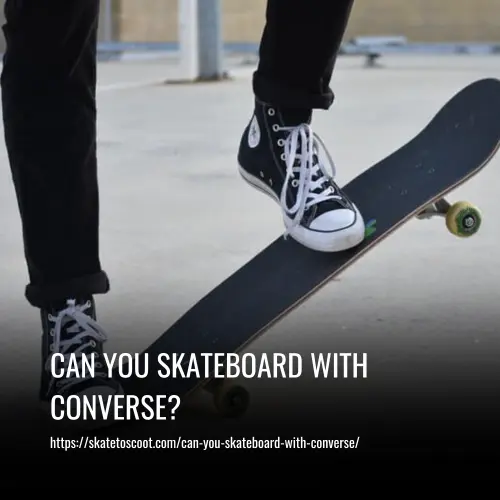As an Amazon Associate we earn from qualifying purchases.
Riding a hoverboard may seem intimidating for beginners, but with the proper steps and safety measures, anyone can learn how to ride one. Here are the easy steps on how to ride a hoverboard properly:
- Place the Hoverboard on an Even Surface.
- Turn on the Hoverboard.
- One Foot at a Time.
- Moving forward and backward.
- Turning.
- Spinning.

1. Place the Hoverboard on an Even Surface:
Placing your hoverboard on an even surface is the easiest way to learn how to ride. An even surface will help you find your balance and control the hoverboard better. It is recommended to start on a flat surface to prevent any accidents.
2. Turn on the Hoverboard:
Before riding, make sure the hoverboard is turned on. The self-balancing gyroscope assists the rider in maintaining balance, so it is crucial to activate this feature before riding.
3. One Foot at a Time:
Put one foot on the hoverboard and position your other foot close to the wheels. Once you have found your balance, put your second foot on the hoverboard while keeping a wide stance for better stability.
4. Find Your Balance:
Before trying to move, try to find your balance and keep your feet on the board by standing still. This may take some practice, but once you feel comfortable, you can start riding.
5. Moving forward and backward:
To properly move forward and backward on a hoverboard, it is important to master the proper technique. Begin by using your ankles to tilt slightly forward to move forward. To move backward, shift your weight slightly backward onto your heels.
During this motion, it is important to keep your waist straight to maintain proper balance. Take your time and practice moving forward and backward until you feel comfortable with this action.
6. Turning:
Now that you have mastered moving forward and backward, it is time to take your hoverboard riding skills to the next level by learning how to turn. Turning is an essential skill to have while riding a hoverboard and can be easily mastered with proper understanding and practice.
To successfully turn on a hoverboard, it is important to understand the importance of weight shifting and balance. Turning requires a precise movement that can be achieved with the slightest pressure from the dominant foot.
For turning left, begin by leaning slightly on your right toe while pushing it ever so lightly. This movement will shift your weight in the opposite direction, leaning you toward your desired turn. While doing so, keep your left foot still and lean a bit in the direction you want to go.
Similarly, to turn right, lean on your left toe and push it lightly to shift your weight in the opposite direction. At the same time, keep your right foot still and lean in the direction you want to go to.
7. Spinning:
Spinning around in a directional circle on a hoverboard is one of the most impressive moves one can perform. To execute this move, you must first establish a stable footing by shifting your weight and maintaining your balance, just as you would when turning.
Begin by turning either left or right, depending on the direction in which you wish to spin. Once you have completed half the turn, shift your weight and lean toward the opposite direction. Keep your feet steady and your balance intact as you complete the full circle.
As with any move that involves turning and shifting your weight, it’s important to maintain your balance throughout the entire spin. Keep your feet firmly planted on the foot pads, maintain a relaxed and focused body posture, and keep your eyes focused on the direction you wish to go.
Safety Measures When Riding a Hoverboard:
Learning how to ride a hoverboard is not just about mastering the steps, but also about taking safety measures to prevent accidents. Here are some safety measures to keep in mind:
- Wear proper safety gear, such as knee pads, elbow pads, wrist guards, and a helmet.
- Keep a slow speed, especially when starting to ride and on uneven surfaces.
- Always ride on a flat and level surface without any obstacles.
- Shift your weight correctly to control the hoverboard’s movement.
- Always use the hoverboard’s learning mode when you are a beginner.
- Do not ride a hoverboard in crowded public spaces.
- Use the proper hoverboard model and check the battery gauge before riding.
- Always disclose affiliate links for any hoverboard-related items.
With a bit of practice and patience, anyone can learn how to ride a hoverboard safely and in no time.
Before You Get On Board:
Before taking your first ride on a hoverboard, there are a few things you should keep in mind. Firstly, ensure that your hoverboard is fully charged and all screws are tight, just to be on the safer side.
While most hoverboards come pre-assembled and calibrated, it’s wise to calibrate your board if it needs calibration. You can follow five easy steps to do so, but make sure to check your manual for accuracy.
Turn off your board and place it on a flat and leveled surface, then press and hold the power button for five seconds until you hear a beep. Wait until the light stops flashing, and then turn on your board.
Hoverboard Set-Up and Calibration
Before you start zipping around on your hoverboard, it’s crucial to ensure that it is fully charged. Most hoverboards come pre-assembled and pre-calibrated, making them ready to use straight out of the box. However, you must check all screws to ensure they are tight when you first get your device.
Calibration is an essential step to ensure your hoverboard performs optimally. If required, you can set up your device in five easy steps. First, ensure the board is turned off and not in sleep mode. Then, place the hoverboard on a flat and leveled surface.
What is the minimum age for a hoverboard?
When considering purchasing a hoverboard for your child, it’s important to note that most models are designed for kids 8 years old and older. However, determining if your child is ready to ride depends on their level of balance and coordination, which can vary from child to child.
To ensure your child’s safety while riding a hoverboard, it’s important to follow the minimum age requirement and invest in proper safety gear. Different hoverboard models may also have varying maximum speeds, with those for children ranging from about 6 mph to 9 mph. Be sure to choose a hoverboard that fits your child’s age and skill level, while taking all necessary safety measures.
Hoverboard Riding Tips
Hoverboard riding can be a thrilling and exciting experience, but it requires proper safety measures and equipment. In this article, we will provide you with essential tips to help you ride your hoverboard smoothly, safely, and confidently.
From choosing the right safety gear to mastering basic movements, we’ve got you covered. Read on to learn more about hoverboard riding tips.
1. Put Your Feet as Close to the Wheels as Possible:
To get started with your hoverboard, first, make sure you unpack and fully charge it. Once fully charged, find a flat, smooth surface to practice on and place the hoverboard in front of you.
To ensure stability and balance while riding, it’s important to position your feet correctly on the foot pads. When mounting the hoverboard, make sure to place your feet as close to the wheels as possible. Doing so allows for better control and maneuverability while riding.
Furthermore, be mindful of your dominant foot when mounting the hoverboard. Place that foot first, so that you have better control over the board. Once your dominant foot is securely on the foot pad, place your other foot on the other shoe, keeping it flat and relaxed.
2. How to Move Around on a Hoverboard:
Moving around on a hoverboard is all about finding the right balance. To get started, step onto the foot pads and make sure your feet are correctly placed. Position your feet as close to the wheels as possible to maintain stability and control while riding.
Once you’re on the hoverboard, use your body weight to control its movement. Leaning slightly forward will move the hoverboard forward while leaning backward causes it to go in the opposite direction. Keep in mind, balancing is key, so don’t lean too much or you might fall.
Turning on a hoverboard is about making subtle adjustments to your feet and body weight. To turn left, slightly shift your weight to your left foot, and the hoverboard will begin to move in that direction. Turning right is the same – shift your weight to your right foot to steer the hoverboard in that direction.
3. How to Turn a Hoverboard:
To make a turn on your hoverboard, you will need to twist your feet in the opposite direction of where you want to go. Let’s say you want to turn left. Twist your right foot slightly by placing it forward, and the hoverboard should naturally turn towards the left. This technique is all about keeping your balance and making subtle movements.
If you want to take a quick turn, you can twist the opposite foot further in that direction. For a left turn, twist your right foot forward and your left foot slightly backward. This should make the hoverboard turn at a sharper angle. But, be careful not to over-twist and lose your balance.
4. Practice, Practice, Practice!
As with any new skill, the key to successfully riding a hoverboard is practice. As you become more familiar with the basic movements, you will begin to develop muscle memory that will improve your overall confidence while riding.
To get started, find a safe and open practice spot where you can take laps and practice turns. This type of repetition will help you get comfortable with the hoverboard and create a solid foundation for more complex maneuvers.
While the learning curve may seem steep at first, consistent practice will help you gradually improve until you feel confident on your hoverboard. Remember to focus on the basics, such as weight distribution and shifting, as you work towards smoother and more precise movements.
How to Get Off of a Hoverboard
The dismounting technique for a hoverboard is a simple process that requires you to do the opposite of what you did when you got on. First, bring the hoverboard to a stop using the same pressure you applied to get moving. Next, increase the pressure on your dominant foot and remove the other foot from the footrest.
It’s important to note that jumping off the hoverboard can result in injury and damage to the board. Using the basic dismounting technique will keep both you and your hoverboard safe.
While getting on and off may be the most difficult part of hoverboarding, it is essential for your safety and control. Practicing dismounting regularly will help you perfect the skill and keep you from getting injured.
Remember, safety should always be your top priority while using a hoverboard. By practicing the proper dismounting technique and using your dominant foot, you’ll minimize your risk of injury and ensure a smooth and safe ride.
What to Avoid When Riding a Hoverboard
Hoverboards are fun to ride and can take you anywhere quickly, but it’s essential to understand the things to avoid to ensure your safety and the safety of others around you. Here are some safety measures you should take:
1. Avoid Looking Down:
Once you are comfortable enough with riding your hoverboard, avoid looking at your feet. Instead, pay attention to the surface in front of you because looking down can confuse you, and you could end up colliding with something. Keeping your head up helps maintain your balance and keeps you aware of your surroundings.
2. Avoid Trying Tricks:
Hoverboards are not designed for you to try out skateboard tricks. These self-balancing scooters aren’t made to handle the kind of pressure that doing tricks entails, and attempting to do so could cause a potential accident. It’s best to use the hoverboards for their intended purpose, which is getting from one place to another.
3. Bending Your Knees:
While it may seem like a good idea to bend your knees to increase balance and stability, it can adversely impact your weight placement. The self-balancing gyroscope cannot function correctly when your body weight is distributed incorrectly. This can lead to instability and potentially lead to an accident.
The Importance of Proper Safety Gear
Riding a hoverboard is not without its risks, so it’s essential to have the proper safety gear to avoid getting hurt. Knee pads, elbow pads, wrist guards, and tailbone protectors are all essential for ensuring your safety while riding a hoverboard.
1. Designated Speed Limit:
All hoverboard models have a designated speed limit, and it’s important to adhere to it. Going too fast can lead to accidents, and the faster you go, the harder the fall. Be mindful of the maximum speed and ride at slow speeds when necessary.
2. Awareness:
One of the most important things to remember when riding a hoverboard is to stay aware of your surroundings. When riding in a public space, remember to be considerate of others around you, and keep an eye out for any obstacles or hazards. Always be mindful of pedestrians and keep a safe distance from them.
FAQs
Begin by stepping onto the hoverboard with one foot at a time, making sure your feet are evenly spaced. Shift your weight slightly forward to initiate movement.
Stand with your feet shoulder-width apart to maintain balance. Keep your knees slightly bent and your body upright, distributing your weight equally on both feet.
To turn on a hoverboard, press the power button and engage the sensors by placing your feet on the footpads. To steer, lean your body forward to go forward and backward to reverse. To turn, shift your weight gently to the left or right.
Smooth and flat surfaces are the best for hoverboard riding. Avoid uneven or rough terrain, as it may cause instability and affect the hoverboard’s performance.
To stop, gradually lean backward, allowing the hoverboard to slow down. Avoid sudden or jerky movements to prevent loss of balance.
Yes, wear appropriate safety gear like a helmet, knee pads, and elbow pads. Start practicing in an open area away from obstacles and pedestrians. Always follow the manufacturer’s guidelines and recommended age restrictions for safe riding.
Conclusion:
This article provides a comprehensive guide on how to ride a hoverboard safely and effectively. By following the safety measures and tips outlined, beginner riders can avoid accidents and enjoy a smooth ride.
Remember to always wear proper safety gear, stay aware of your surroundings, and adhere to the designated speed limit. With a bit of practice and patience, anyone can master the basic movements and subtle weight shifts required to ride a hoverboard. Happy riding!
Amazon and the Amazon logo are trademarks of Amazon.com, Inc, or its affiliates.



